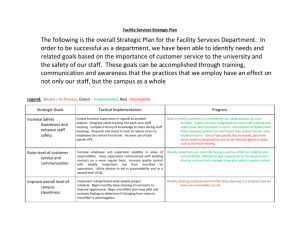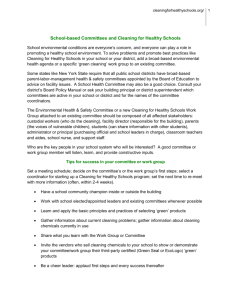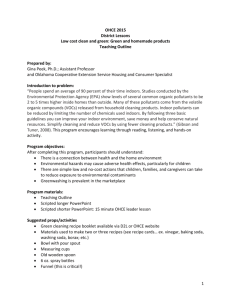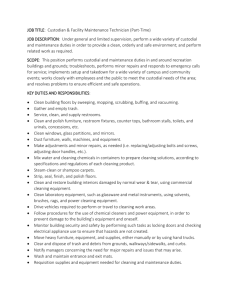Policy Procedures
advertisement
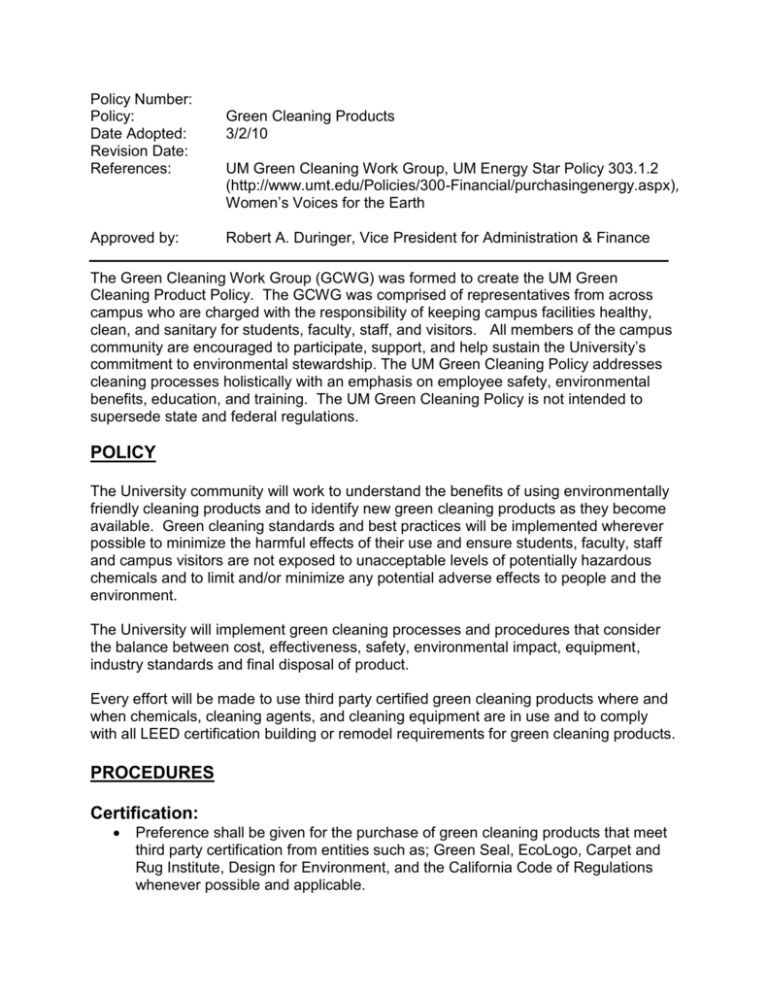
Policy Number: Policy: Date Adopted: Revision Date: References: Approved by: Green Cleaning Products 3/2/10 UM Green Cleaning Work Group, UM Energy Star Policy 303.1.2 (http://www.umt.edu/Policies/300-Financial/purchasingenergy.aspx), Women’s Voices for the Earth Robert A. Duringer, Vice President for Administration & Finance The Green Cleaning Work Group (GCWG) was formed to create the UM Green Cleaning Product Policy. The GCWG was comprised of representatives from across campus who are charged with the responsibility of keeping campus facilities healthy, clean, and sanitary for students, faculty, staff, and visitors. All members of the campus community are encouraged to participate, support, and help sustain the University’s commitment to environmental stewardship. The UM Green Cleaning Policy addresses cleaning processes holistically with an emphasis on employee safety, environmental benefits, education, and training. The UM Green Cleaning Policy is not intended to supersede state and federal regulations. POLICY The University community will work to understand the benefits of using environmentally friendly cleaning products and to identify new green cleaning products as they become available. Green cleaning standards and best practices will be implemented wherever possible to minimize the harmful effects of their use and ensure students, faculty, staff and campus visitors are not exposed to unacceptable levels of potentially hazardous chemicals and to limit and/or minimize any potential adverse effects to people and the environment. The University will implement green cleaning processes and procedures that consider the balance between cost, effectiveness, safety, environmental impact, equipment, industry standards and final disposal of product. Every effort will be made to use third party certified green cleaning products where and when chemicals, cleaning agents, and cleaning equipment are in use and to comply with all LEED certification building or remodel requirements for green cleaning products. PROCEDURES Certification: Preference shall be given for the purchase of green cleaning products that meet third party certification from entities such as; Green Seal, EcoLogo, Carpet and Rug Institute, Design for Environment, and the California Code of Regulations whenever possible and applicable. An allowance for cleaning chemicals otherwise prohibited may be made in cases where the product application or sanitation requirements (health care, food service) are such that there is no appropriate alternative green cleaning product available. o Limit disinfectant applications to the appropriate setting, amount, and target organism. When selecting disinfectant products: Choose a product specific to the disinfection needs Assess or minimize risk to patients and staff Thoroughly clean before use Use the product in the most efficient manner and; As ‘proper use’ is indicated on label directions Equipment: Floor Care: The Carpet and Rug Institute (CRI) shall be the third party rating agency for floor care consultation regarding energy efficiency, product usage, HEPA filtration, water recovery, water dispensing to minimize waste, and water extraction equipment. Floor care equipment shall meet the recommendations of CRI whenever possible. Regardless of CRI recommendation, floor care equipment shall be capable of removing sufficient moisture such that carpets can dry within a 24 hour period. Utilization and dispensing: o Consistency: Dispensing systems that regulate chemical concentrates are to be used for dilution control. When manual dilution is utilized, proper training and measurements are to be implemented. o Cold water is to be used when mixing cleaning chemicals (cold water uses less energy, and hot water can release fumes) unless heated water is required for proper activation. Emissions: Preference should be given to equipment that reduces or eliminates aerosolization. Preventative products: such as entrance matting shall be utilized where practical to minimize cleaning needs. Batteries: Where batteries are essential or required utilize rechargeable batteries as your first choice. If rechargeable batteries are not available utilize the most environmentally friendly battery technology available. Purchasing: Capital Purchases: Cleaning equipment purchases must meet UM’s Energy Star Policy number 303.1.2 http://www.umt.edu/Policies/300Financial/purchasingenergy.aspx Efficient Ordering: o Delivery schedule coordination. Products should not be ordered in excess of expected use of product shelf life. o Bulk (concentrates and consolidated case orders, etc.) should be considered as a means to manage cleaning supply costs. o Central Stores-Helena should be considered for purchases whenever practical. o Advantages of group purchasing to be further explored. UM Missoula UM Campuses (Dillon, Butte and Helena) MUS All State Intuitions Consolidated Inventory: Products should be evaluated and standardized across campus to reduce the total number of different materials and harmful chemicals currently in use. The inventory of chemicals used should be maintained on the “UM Chemical Assessment and Inventory Form.” Preference shall be given to cleaning products that are cost-effective and effective in their application. Preference shall be given for products that are packaged in a container of recycled material, and/or contained in recyclable packaging. Preference for products that do not contain phosphate, zinc, and/or aerosol delivery. Oversight, Training & Education: Oversight: Under the leadership and direction of the Office of Sustainability, create a standing work group comprised of Facilities Managers and the ASUM Sustainability Coordinator to: o Reduce the overall chemical inventory on campus as identified in the “UM Chemical Assessment and Inventory Form” o Increase the use of green cleaning products across all sectors of campus. o Develop a process to field evaluate new green cleaning products, to include standardized product testing and assessment procedures. o Create an approval process for all non-third party certified cleaning products utilized on campus. o Provide ongoing oversight for UM Green Cleaning Product Policy compliance. o Provide the SCC with an annual report highlighting work group activity and compliance with the UM Green Cleaning Product Policy. Training: Facilities Managers shall develop a program for initial and continued training to include, but not be limited to: o Contents and application of the UM Green Cleaning Policy. o Safe handling and disposing of cleaning materials. o Proper mixing and dilution of concentrated chemicals. o How to read an MSDS sheet and identify where they’re located. o Compliance with all current policies, legislation, and industry standards. o Encourage innovation and recommendations for product research. Product Research: o Continue researching products, equipment, tools and procedures that are safe for our health and environment. o Utilize a standardized field evaluation form. o Utilize standard testing and assessment procedures which would include: Effectiveness Cost analysis Safety Environmental fate and disposal Education: (Campus community outreach): o Create a program that raises student awareness of green cleaning products. o Promote and encourage students to purchase and use green cleaning products in the residence halls.

